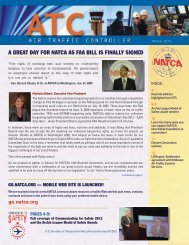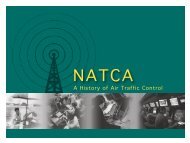Against the Wind - National Air Traffic Controllers Association
Against the Wind - National Air Traffic Controllers Association
Against the Wind - National Air Traffic Controllers Association
You also want an ePaper? Increase the reach of your titles
YUMPU automatically turns print PDFs into web optimized ePapers that Google loves.
Emerging from <strong>the</strong> Dark Ages<br />
Leyden and Poli held diametrically opposing<br />
views on <strong>the</strong> union’s path to success, but <strong>the</strong>y were<br />
driven by identical goals. Those same strong sentiments<br />
had stirred controllers for decades and created<br />
a cohesive sense of purpose that prompted Leyden,<br />
Poli, and <strong>the</strong>ir colleagues to seek <strong>the</strong> protection of a<br />
union. The motivation was so powerful that it survived<br />
PATCO’s subsequent dismemberment and fueled<br />
a second organizing effort a mere two years later<br />
among a predominantly different work force.<br />
Leyden had served in <strong>the</strong> military before entering<br />
<strong>the</strong> private sector, a typical career path for many<br />
controllers in his day. After <strong>the</strong> Federal Aviation<br />
Agency hired him in early 1959, he received basic<br />
training at <strong>the</strong> FAA Academy in Oklahoma City and<br />
<strong>the</strong>n settled in at New York Center, located in Hangar<br />
11 at Idlewild <strong>Air</strong>port (now Kennedy).<br />
Federal-sector unions did not exist yet. Leyden<br />
and his Hangar 11 crew even worked some sectors<br />
without <strong>the</strong> benefit of flattop radarscopes, let alone<br />
computerized flight information.<br />
Instead, <strong>the</strong>y used small plastic “shrimp<br />
boats”—so named because of <strong>the</strong>ir resemblance<br />
to fishing vessels—which contained slips of paper<br />
about each flight. <strong>Controllers</strong> pushed <strong>the</strong> shrimp<br />
boats on <strong>the</strong> scopes as <strong>the</strong> targets for <strong>the</strong>ir planes<br />
inched across <strong>the</strong> glass. Coordination with approach<br />
1980<br />
15<br />
Aug.<br />
controllers was handled by telephone.<br />
They separated traffic by 1,000 feet vertically<br />
and relied on pilot time estimates for arriving at<br />
navigational fixes to maintain lateral distances of<br />
10 minutes, an inefficiency that translated into<br />
more than ten times <strong>the</strong> horizontal spacing used<br />
today. The reliance on estimates also led to frequent<br />
separation errors.<br />
Chapter 1: ATC Comes of Age<br />
<strong>National</strong> Archives<br />
Pushing plastic: Washington Center controllers in 1955 monitored aircraft with surplus radarscopes built for Navy<br />
battleships in World War II. They identified each target using a plastic “shrimp boat” that contained flight information.<br />
PATCO controllers stage a one-day slowdown at O’Hare International<br />
<strong>Air</strong>port that causes 616 delays of thirty minutes or more and costs <strong>the</strong> airlines<br />
more than $1 million in wasted fuel. The slowdown follows <strong>the</strong> FAA’s<br />
15<br />
refusal to pay O’Hare controllers an annual tax-free bonus of $7,500 and<br />
upgrade <strong>the</strong> tower to Level V. All o<strong>the</strong>r control towers are classified as<br />
Level IV. The agency calls <strong>the</strong> O’Hare demand “non-negotiable.”




